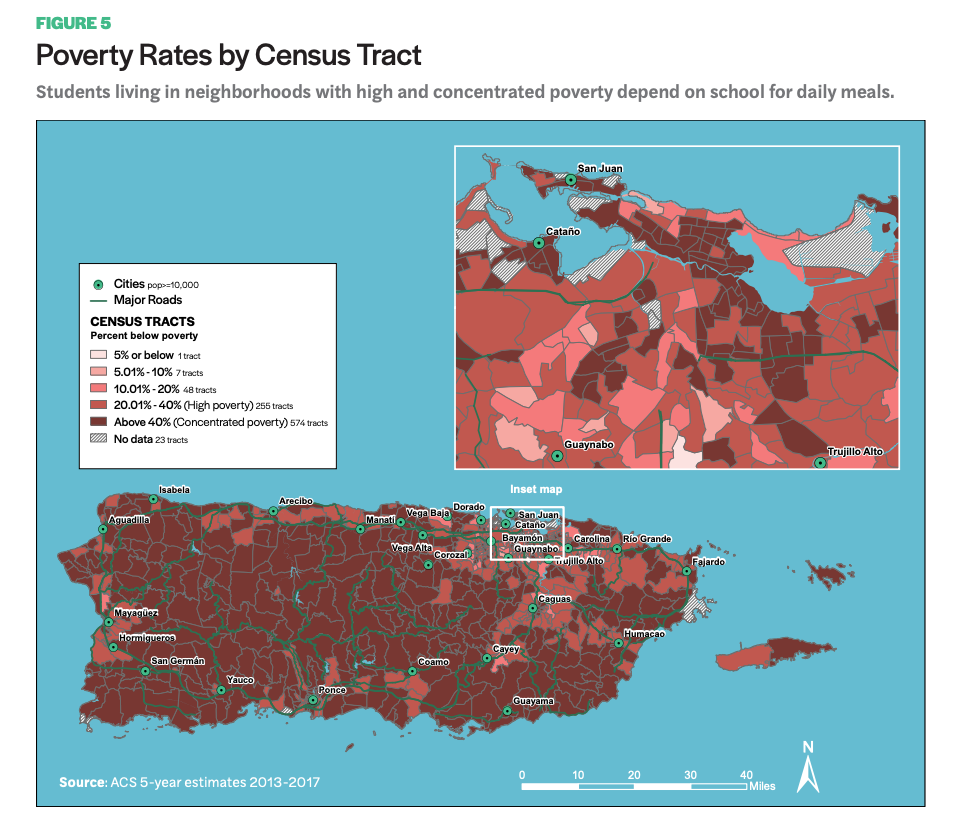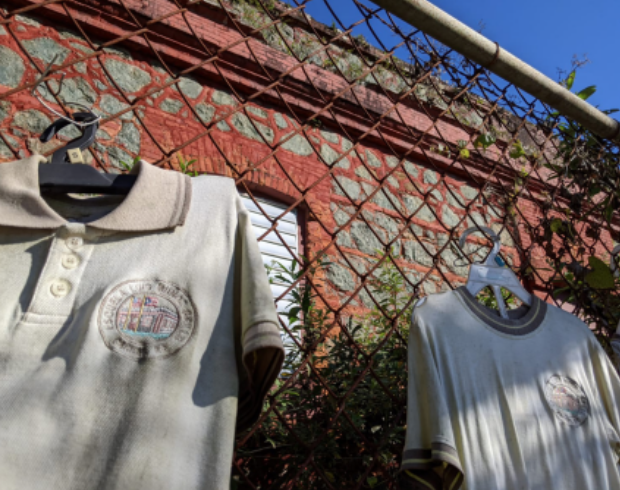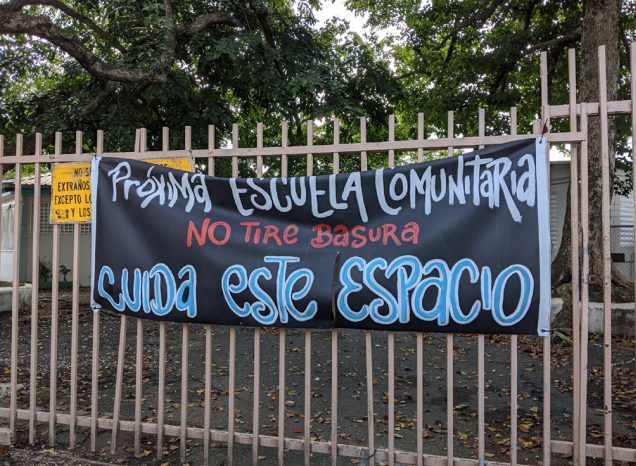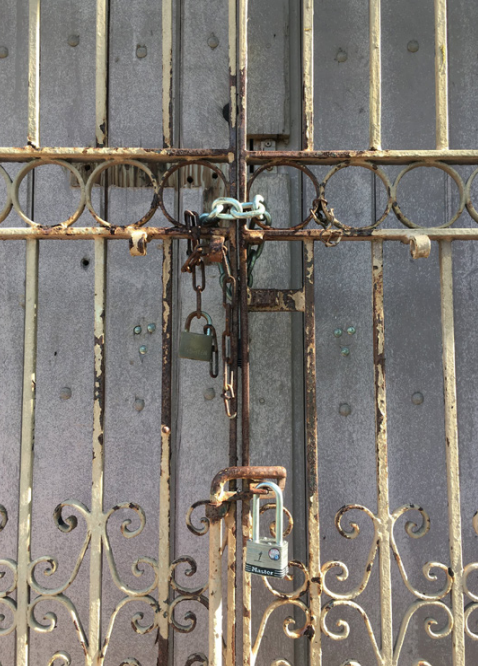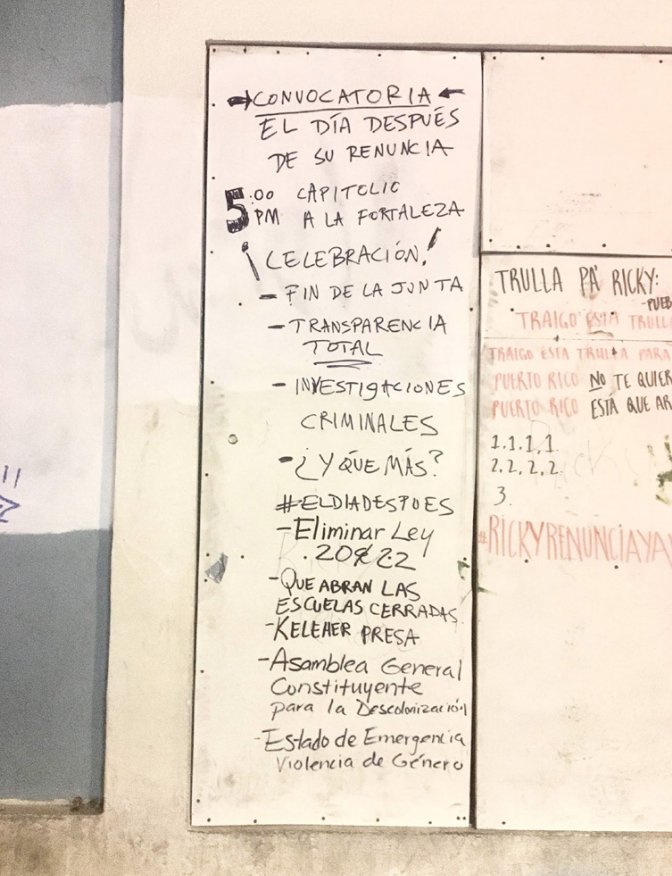Schools at the Core of Surrounding Communities
SCHOOLS IN PUERTO RICO serve as polling stations during elections, shelters during hurricanes, and centers for emergency response during public health crises. These essential functions demonstrate that schools represent a community core for their neighborhoods. Understanding the effects of school closures requires a recognition of the wide-reaching meaning and web of relationships that schools hold. Far more than just buildings for protection from the elements during educational instruction, schools play essential roles in the social, economic, and cultural life of a community. In her study on the subject, Ariel Bierbaum identified numerous types of meaning and value of schools (figure 4). In the economic sphere, schools influence housing values, residents’ future earnings, current income, district solvency, and the local tax base. In socio-spatial terms, schools affect the safe passage of children and families, offer social and political capital, and function as anchor institutions for community groups, businesses, and other networks. The symbolic and cultural value of schools includes their role as sites that define the identity of a place, people’s sense of belonging, and a place to raise and address community concerns.
Community Identity and History
Long-standing neighborhood schools have great meaning for local families. In the mountainous town of Aguas Buenas, one grandmother spoke in a focus group about her grandchildren attending the Josefa Pastrana school. She herself had graduated from the same school decades earlier, forging a deeply personal and generational connection that is now lost due to the school’s closure in 2013. Pastrana notified parents in the spring that it would not open again in the fall. According to a staff member, the regional school district claimed that Pastrana would only be temporarily closed and would reopen as a middle school, which she believed circumvented parents and community members from organizing to oppose its closure. Pastrana’s closure severed the family’s relationship to its community and also to its own familial traditions, fracturing the community as parents scrambled to register their children in other schools. Some of the displaced students had to repeat the process again when their new school also announced closure the following year. Today, Pastrana school remains closed, vandalized, and scattered with garbage, rubble, textbooks, and even human waste.
“Some schools are supposed to be a monument to our history,” Marina Moscoso Arabía, Coordinator of Casa Taft 169, shared as she led a tour of the Goyco elementary school in San Juan. The school, located in the Machuchal neighborhood, was named after Pedro G. Goyco, a nineteenth-century political leader and abolitionist, who may have been buried under the school, according to Moscoso. In 2015, parents of the students at Goyco received a letter notifying them the school would be closed within two months. There was no public meeting or consultation with parents before the decision was made, nor an organized process to reassign students to new schools. Similarly, of the 82 vacant schools visited for the purpose of this research, 8 (10%) were observable historic properties or had the potential of being declared as such.
The closure of the Goyco school and the overall trend of school closures fits in the broader historical context of Puerto Rico’s education system, which is a contested history with several transformations.26 Originating with very few schools established by the Catholic Church before the nineteenth century, the first schools of Puerto Rico were available only to a small number of white, male children. In the nineteenth century, education shifted to a growing public system still controlled by the Catholic Church, although it continued to serve only a narrow population and perpetuated racial, economic, and gender inequities. A snapshot of the children attending schools in 1864 provides context: Of an estimated 600,000 inhabitants, there were about 35,000 enslaved people, including about 5,250 enslaved children who were not permitted to attend school. Of the 84,750 free children, only 4,187 (less than 5%) attended school.27
During the twentieth century, the archipelago’s education system was transformed to a markedly expanded public and private school system, widely accessible and inclusive though still unequal in terms of social class and race.28 The number of students in public schools rose, from 545,000 in 1956 to its peak of 728,000 students in 1978.29 It is worth noting that the period of expanded access to education from 1930 to 1950 followed three hurricanes and a severe recession between 1928 and 1932. In response, Puerto Rican leaders developed the Puerto Rico Reconstruction Administration, which was funded through New Deal legislation and resulted in the construction of 299 public schools, 38 secondary buildings, and new public university buildings, among other projects.30
After 1978, the overall population in Puerto Rico began a downward trend, as did the number of school age children, and the number of public schools and public school students declined. Over the thirty-year period of 1981 to 2011, the number of people under age eighteen decreased from 1,221,000 to 903,000 (-26%). The number of public schools in Puerto Rico was reduced from 1,803 to 1,464 (-18%). During the same period, the number of public school students fell from 710,000 to 453,000 (-28%), while the number of private school students rose by 60%. During the 2009-2010 academic year, there were some 461,000 students (78%) attending public schools and 130,000 students (22%) attending private schools. 31
The widespread closures of public schools in Puerto Rico over the last decade are an intensification of a thirty-year trend. The generation of Puerto Ricans who attended school in the 1960s and 1970s recall an era of expanding access and improvements in quality. The closure of schools like Goyco is symbolic of the abandonment of this expansion and harkens to an earlier era of exclusionary access.
Essential Community Centers
Schools are more than sites of learning for children. During the school year, thousands of children rely on food served at school to meet their daily nutritional intake, given that the majority of neighborhoods across the archipelago have high concentrations of families living below the poverty line (figure 5). Additionally, in Puerto Rico, school buildings often serve as emergency shelters during hurricanes, voting centers during elections, and a place of connection where parents and neighbors build trusting relationships with each other. They also serve as public health sites when there is an outbreak of dengue and other illnesses, becoming a central location to provide information and treatment. Of the 82 vacant school buildings visited for the purpose of this research (to be discussed further in the section Conditions at the Closed School Buildings), 36 (44%) schools featured some sort of sport or recreational facilities, such as basketball courts, baseball fields, or theatres, which in turn are often utilized by the greater community. Closed schools have resulted in the loss of these valuable community functions.
The term “community school” is used to reflect this broader role schools can have in Puerto Rico. Ana María García Blanco, Executive Director of Instituto Nueva Escuela, which supports Montessori public schools in Puerto Rico, explains: “A community school is both a place and a set of partnerships between the school and other community resources. Its integrated focus on academics, health and social services, youth and community development, and community engagement leads to improved student learning, stronger families, and healthier communities. Schools become centers of the community and are open to everyone—all day, every day, evenings and weekends.” The community school brings together a range of actors who are vital for community well-being—of which student academic success and the student-teacher relationship is one part. In the case of Puerto Rico, “community school” is a term that better captures the historic relationship between schools and the communities they serve.32
The unique characteristics of a community school advance the resilience of entire communities by providing services tailored for different parts of the communities they serve. Therefore, cutting off or dismantling a community school can exact a steep toll on communities.
Community school closures disrupt a unique sense of belonging that schools create. A closure can rupture intergenerational shared experiences, reduce parental and community involvement both at school and with their children’s education, and disperse the influence of the community in the governance of their school. These impacts alienate communities and erode belonging, described by Bonnie Benard as “a basic human need, a fundamental motivation, sufficient to drive behaviors and perceptions. [Feeling of belonging] leads to positive gains such as happiness, elation, achievement, and optimal functioning…Its importance cannot be stressed enough.”33
The association between individual and community resilience and a sense of belonging is well documented.34 In particular, the role of belonging—defined as the positive effects of particular types of social capital—holds exceptional value in education for students, teachers, and the communities networked by schools. “Strong communities are connected communities, where people feel they belong, they matter, and their participation is facilitated.”35 “Community” can be defined geographically, by communities of interests, or by communities of emotional connection and interdependence between community members, based on scholarship measuring these associations. “Schools that manage to combine all three [conceptions of community] are more likely to have high levels of social capital.”36
Parent Participation and Democratic Governance
Testimonials on the absence of a planning process leading up to and following the school closures in Puerto Rico emphasize a central concern: “There was no study about the local context, what was needed, and how the school closure would affect us, so there was no plan for making the closures work,” as one community leader put it. At the Goyco school, some parents and volunteers felt the effort to close the school had started months prior to the announcement, when the administration made decisions to make the school environment “unbearable,” according to one parent, including lack of supervision, materials, teachers, clean working toilets, and other critical infrastructure. Parents were particularly upset when school leadership forced students to play during confined recreational time in the unshaded courtyard during the hottest part of the day, while the school lacked running potable water, which parents perceived as escalated and intentional disinvestment. The school had four different principals in the year before it closed, and volunteer projects like planting trees in the barren yard were denied support.
Given the multiple functions schools serve in the community, closures can have significant ripple effects on public participation and exacerbate distrust in government. For example, in a study in Richmond, Virginia, the process for closing schools “drove a rapid and antagonistic decision-making process that minimized broad-based public participation.”37 The Pew Charitable Trusts’ Philadelphia study warned that such quick and opaque decision-making processes, which lack community input, can further increase distrust in both the school district and government in general, even leading to the ousting of public officials.38 This trend played out in Puerto Rico during the political upheaval in summer 2019, which included the governor’s ouster following the Secretary of Education’s Julia Kehler resignation after multiple federal fraud indictments. The mass mobilizations that led to the resignations were due to many economic and political factors, and one consistent rallying cry at protests included the inhumane cuts to public services like education.
In a related study of majority Latinx schools in Santa Barbara, California, there was a 29% drop in parent participation following school closures, including drops in attending parent-teacher conferences, Parent Teacher Association meetings, or accompanying field trips.39 Parents reported that they participated more in the original schools preclosure because of the sense of neighborhood community, including cultural activities and proximity. The loss of belonging negatively affected parent involvement. In Puerto Rico, partly due to the lack of a systematized reassignment process for students attending a school slated for closure, some parents are unable to participate in new schools because each of their children end up attending different schools. For example, one parent’s neighbor had three children who each went to a different school after their original elementary and middle schools shut down at different times, leaving the parent with longer commutes and less time to participate in any of the three schools. Combining or “consolidating” elementary, middle, and/or high schools also increases the frequency of displacement for students. A student starting their first year of middle school, for example, may find themselves transferring to a new school for a third time in three years if the new receptor school closes.
Teachers, parents, and students repeatedly shared how there was rarely clear communication from the DE regarding the criteria for selecting certain schools for closure, and there was never a clear process for the actual closure and where students would go. One parent had a child’s school close that was a few blocks from their home. They found a new school they were relatively happy with that was a fifteen-minute drive. But after only two years in the new school, they heard in April 2018 that it would be closing in May. Similarly, an educator who was facilitating a community workshop shared that a participant was in his third high school in as many years due to closures.
Taken together, consistent reports of wholly lacking strategies to consult with parents and communities, to systematize transfer processes postclosure, or to tailor strategies to the different situations of distinct places suggest there was inadequate or no consideration of site-specific needs of Puerto Rican residents. The Department, under Secretary Julia Keleher’s leadership, consistently cited student population decline as the sole rationale for closures, which indicates that decision-makers considered the role of school singularly as “educator.” This ignores the robust comsmunity value of schools described above.
Access to Education
School closures can affect students’ educational experience in myriad ways with changes in location, administration, teachers, student body, facilities, and services offered. Regarding proximity and commute distances, families with low-incomes often do not own cars, creating daily challenges to survive with extremely limited or no access to public school year mushrooming to 80,323, despite a shrinkage in student population.40 As travel time to school increases, research shows students are less able to participate in both extracurricular and in-home activities and have less time for homework; when the commute is over thirty minutes, studies show it impacts both the student and their whole family.41 In fact, dropout rates in Puerto Rico have more than tripled from the 2014–2015 school year to 2019–2020.42
Social Inclusion and Equity
Puerto Rico is a territory composed of majority Latinx and Afro-Latinx people.43 Figure 5 shows that 94% of neighborhoods have high poverty (between 20% and 40% below the federal poverty line) or concentrated poverty (over 40% below the federal poverty line). More importantly, data recently published by the Youth Development Institute of Puerto Rico states that 57% of minors in Puerto Rico live under the poverty level, with 39% suffering extreme poverty.44 There is no state in the mainland US with demographics comparable to those of Puerto Rico, or that has experienced school closures at the scale of Puerto Rico. The mainland cities that have closed a significant portion of their public schools, including Chicago, which shuttered 33% of its district between 2002 and 2018 (closed 200 schools),45 and Washington, DC, which closed 25% of its schools since 2008 (48 schools), also have student populations that are predominantly African American and Latinx and come from low-income communities.46
From Chicago to Philadelphia to Puerto Rico, school closures disproportionately impact students who belong to low-income families or are otherwise marginalized, including students of color and those with special needs.47 Exacerbating these social and racial inequities, school closures often weaken protection from discrimination by obfuscating situations where nondiscrimination clauses apply, particularly harming LGBTQ staff and students, as well as students with disabilities.48 For example, voucher programs, including the one instituted by Puerto Rico’s 2018 Education Reform law, can be used for religious schools that may exclude or psychologically harm LGBTQ staff or students or have otherwise selective enrollment that do not serve the needs of students with disabilities.
In Chicago, schools receiving reassigned students with special needs were not prepared with adequate staff and services to support their special education.49 Increased traumatic violence, such as assaults on students traveling to their new school through neighborhoods with rivaling gangs, has been reported by parents and their children who attend new schools due to closures in Philadelphia, Kansas City, and Chicago.50 Though there lacks research in this area for Puerto Rico, a few media reports have hinted toward a connection between violence and school closings.51 Service providers and educators in Puerto Rico have also reported an increase in anxiety among students who were unsure if or when their school might close and were uncertain about where they would attend next in that event.
According to Puerto Rico’s Red por los Derechos de la Niñez y la Juventud, an association of service providers, youth in custody of the state have been uniquely affected by closures because changing schools often means new caseworkers and potential loss of access to special service. When youth in custody of the state are moved to a new school, it can often mean they need to move living facilities, and each facility must figure out transportation for students.
School closures can also exacerbate racial segregation and inequality. In a study of Richmond, Virginia’s school district from 2006 to 2010, school closures were associated with higher levels of segregation, going from a 0.65 to 0.7 score for the white-black dissimilarity index, considered “highly segregated.”52 Further analysis is needed to determine whether this is evident in Puerto Rico. Because of how schools are funded through property taxes in the mainland US, neighborhoods with higher homeownership correlate with higher median income and better performing schools. Figure 6 underscores the unique context of Puerto Rico compared to US states because census tracts with high rates of homeownership do not correlate with higher incomes or fewer closed schools. Additionally, Puerto Rico does not have local school districts, as all schools fall under the centralized DE and operate independent of municipal property tax bases. Yet, like many families in the mainland US, when Puerto Rican families consider buying property, they often take into account the presence and proximity of a school. When comparing the homeownership rate (figure 6) to the geography of closed schools (figure 3), it is clear homeownership rates do not insulate against school closures. This is partly due to Puerto Rico’s funding structure for education, which is unrelated to property tax revenue as there is no funding from local sources for education in Puerto Rico.53
- 26Throughout the 1700s, there were very few schools in Puerto Rico, and most of them were established and administered by the Catholic Church. These schools were available to a select few boys of European descent, while girls and children of enslaved Africans, free people of African descent, Indigenous people, and poor and rural white children did not have access to them. In the 1800s, schools funded and managed by the Spanish colonial government and municipalities were created, although they still only reached a small percentage of the children, required payment from parents, and involved religious officials in the approval of teachers and school curriculum.
- 27Alfonso López Yustos, Historia Documental de la Educación en Puerto Rico, 1503–1970, (Puerto Rico: Sandeman, 1985), 44.
- 28Ibid.; Roamé Torres González et al., Educación básica en Puerto Rico del 1980 al 2012: Política pública y trasfondo histórico, legal y curricular.
- 29Alfonso López Yustos, Historia documental de la educación en Puerto Rico, 1503-1970, 260.
- 30Ibid., 126.
- 31Roamé Torres González et al., Educación básica en Puerto Rico del 1980 al 2012: Política pública y trasfondo histórico, legal y curricular.
- 32In the US context, the import of “community schools” has been used as a code word to justify educational inequality in the landscape of extreme residential segregation. Nevertheless, this report draws on the term in order to capture the unique role schools serve in cities and towns in which they are located and the different residential patterns in the territory that accord those schools different meanings within close proximity to their students’ and neighbors’ residences. For more, see Eduardo Bonilla-Silva’s Racism without Racists (2009).
- 33Bonnie Bernard, “Fostering resiliency in kids: Protective factors in the family, school, and community“ (1991).
- 34Robert Blum, “A Case for School Connectedness,” Educational Leadership 62, no. 7 (2005): 16-20; Heather P. Libbey, “Measuring Student Relationships to School: Attachment, Bonding, Connectedness, and Engagement,” Journal of School Health 74, no. 7 (2004): 274-283; Sue Roffey, “Emotional literacy and the ecology of school wellbeing,” Educational and Child Psychology 25, no. 2 (2008): 29-39.
- 35Sue Roffey, “Educational and Child Psychology,” British Psychological Society 30, no. 1 (2013): 38-49.
- 36Ibid.
- 37Genevieve Siegel-Hawley, Kimberly Bridges, and Thomas J. Shields, “Solidifying Segregation or Pro-g moting Diversity? School Closure and Rezoning in an Urban District,” Educational Administration Quarterly 53, no. 1 (2017): 107-141.
- 38Emily Dowdall, “Closing Public Schools in Philadelphia: Lessons from Six Urban Districts” (Philadelphia: Pew Charitable Trusts, 2011).
- 39Richard Valencia, “Public School Closures and Policy Issues: Financial and Social Implications,” Public Budgeting and Finance 5, no. 1 (1985): 50.
- 40Istra Pacheco, “Un Palo Cambio en Transporte Escolar,” Primera Hora (August 8, 2016), https:// www.primerahora.com/noticias/gobierno-politica/ notas/un-palo-cambio-en-transporte-escolar/; Lyanne Meléndez García, “Alza en Solicitudes de Transporte Escolar,” Metro 20 (May 2019), https://www.metro.pr/pr/noticias/2019/05/20/alza-en-solicitudes-de-tran….
- 41Beth Spence “Long School Bus Rides: Their Effect on School Budgets, Family Life, and Student Achievement,” Rural Education Issue Digest 1, no. 11 (2000): 5-6, https://search-proquest-com.libproxy.berkeley.edu/docview/62328173?acco….
- 42Departamento de Educación, “Reporte de Deserción Escolar en Puerto Rico,” https://estadisticas.pr/en/inventario-de-estadisticas/reporte-de-deserc….
- 43Here “Latinx” refers to Hispanic in the US Census.
- 44“Statistics of Puerto Rico,” Instituto del Desarrollo de la Juventud, accessed on May 6, 2020, http://juventudpr.org/.
- 45Lutton et al., “A Generation of School Closings.”
- 46Valerie Strauss, “How School Closings Affect Children,” Washington Post, March 7, 2013, https://www.washingtonpost.com/news/answer-sheet/wp/2013/03/07/how-scho….
- 47Cohen, “Devastating Impact.”
- 48Julie Mead, and Suzanne Eckes, “How School Privatization Opens the Door for Discrimination” (Boulder, CO: School of Education, University of Colorado Boulder, 2018), 6.
- 49Pauline Lipman and Alicia S. Person, “Students as Collateral Damage? A Preliminary Study of Renaissance 2010 School Closings in the Midsouth,” Educational Policy 21 (2007): 471-502.
- 50Emily Dowdall, “Closing Public Schools in Philadelphia: Lessons from Six Urban Districts,” 13.
- 51Ayeza Díaz Rolón, “Respaldan Pesquisa Sobre Cierre de Escuelas,” El Volcero (March 11, 2019), https://www.elvocero.com/educacion/respaldanpesquisa-sobre-cierre-de-es…. html; “Temen Aumento de Violencia por Cierre de Escuelas en Loíza,” El Vocero (March 25, 2018), https://www.elvocero.com/educacion/temen-aumento-de-violencia-por-cierr….
- 52Siegel-Hawley et al., “Solidifying Segregation,” 109.
- 53National Center for Education Statistics, “Education Demographic and Geographic Estimates,” 2017-2019, https://nces.ed.gov/ccd/districtsearch/district_detail.asp?ID2=7200030.





